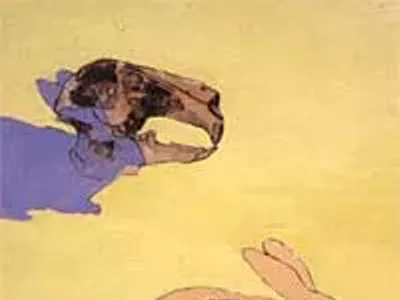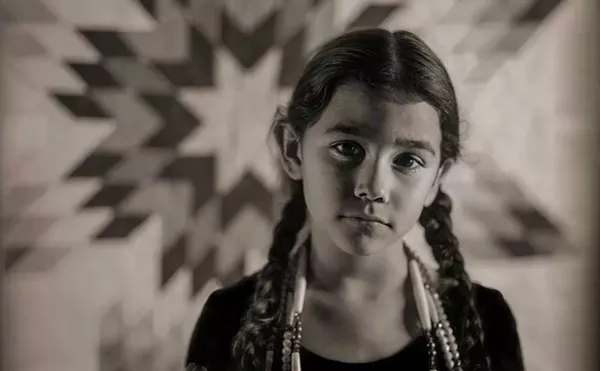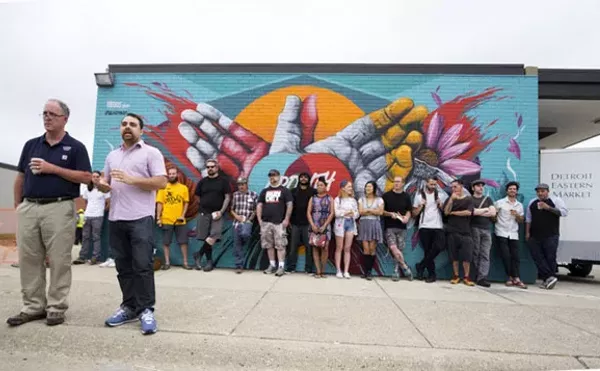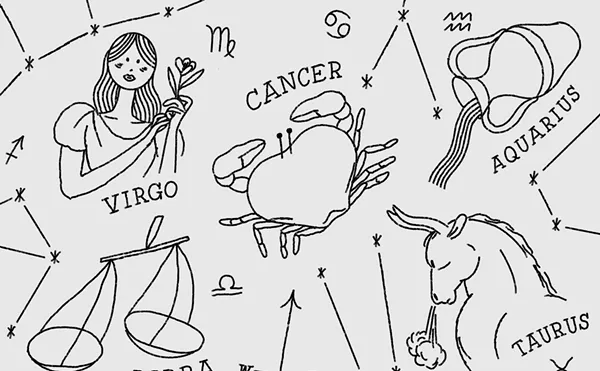
Audio By Carbonatix
[
{
"name": "GPT - Leaderboard - Inline - Content",
"component": "35519556",
"insertPoint": "5th",
"startingPoint": "3",
"requiredCountToDisplay": "3",
"maxInsertions": 100,
"adList": [
{
"adPreset": "LeaderboardInline"
}
]
}
]
Like well-known painter Gerhard Richter, who also studied in Berlin, German-born artists Hartmut Austen and Geka Heinke make art about art. Their MO is irony, pulling on the skirt of modernism.
Theirs is a characteristically German kind of funny, a backhanded analytic humor, presenting puzzles that turn on themselves in ridiculous ways. Their paintings could be visual puns lost in translation, but their shared cynicism is apparent (blame Nietzsche). And for those who like that kind of thing — taking a perverse pleasure in cerebral gamboling and ambivalence — what’s up at P.F. Galleries in Clawson right now is a very engaging show.
Heinke’s large-scale work “Rennbahnen (Race Courses)” is three pieces of Masonite made to look like model racetracks. Painted with a shiny metallic copper and cut in extreme angles, the tracks shoot out into space from the wall, offering drastically different perspectives, as if it’s all an exercise in the illusion of depth. Hung at the front entrance of the gallery, the work is a good introduction to this world where things are not what they seem.
The three “race courses” are positioned in a vertical series on the wall. One track seems to be moving back into deep space, with an implied vanishing point that is raised up and to the left, rather than at the center where it’s usually located. The “middle” track also implies depth, yet the ground plane tips forward. And when looking at the track above, hung a bit farther from the other two, the viewer’s gaze is pulled back and forth like a yo-yo, into a space that is both above eye-level and somewhere around his knees.
In “Garderobe (Coat rack),” Heinke has fun with Masonite again by painting its surface to make it look like wood, creating the illusion of grain by removing paint in strips. On the left side of the piece, the painted pattern tapers off and the surface becomes real wood — this is Heinke letting us in on her joke. But here her intentions seem too heavy-handed. While that sort of irony is more successful in other pieces, such as “Garderobe II (Coat rack II),” in this one there’s too much of the Monty Python wink-wink, nudge-nudge, and these pokes in the ribs just become annoying.
The riddles in Hartmut Austen’s paintings are not about simulation; they’re about the perception of space in landscapes and architecture. Most of the surface in “Freudenberg” is veiled by a ghostly white wash over a barely there gray grid that reads like a topographical map. It also looks like shifting planes of architecture, with such elements as girders, windows or the square rooftops of skyscrapers. At the bottom of the canvas, the ground planes shift again when ochre- and charcoal-colored structures appear to emerge from clouds or mist. It is impressive that Austen can pull so many interpretations from an extreme economy of line.
Likewise in “Condo,” an unidentifiable building is defined by loss. Most of the mass is erased, with details of windows, balconies and doors slipping into semi-abstraction in red, yellow, blue and green. In “Momart” and “Momart II,” buildings have no rooftops, revealing walls and other architectural bare bones rendered in lime green and black strokes. Austen delivers in all works, except “Eleven Skies,” a purely abstract painting of blue and green rectangles on a rust background that’s out of sync with the perceptual and historical qualities of the others.
The show’s title, Berlin: Detroit, suggests a direct ratio between the two places, but viewers will find little reference to either of these cities in the art. Instead, the title refers to the two artists, who were friends in art school in Berlin and now are showing together in metro Detroit. P.F. Galleries’ press release says, “globalization is important to the work.” This sort of curatorial framework is always a stretch when considered as theoretical validation for the art. Still, the show holds together and moves well beyond the everyday art prattle. And perhaps even a small amount of cross-fertilization between the two cities, via the artists, helps to prove that it’s about time for Nietzsche to lighten up.
Runs through Jan. 8 at P.F. Galleries, 213 E. 14 Mile Rd., Clawson; 248-989-8889.
Gerry Craig writes about art for Metro Times. Send comments to letters@metrotimes.com





